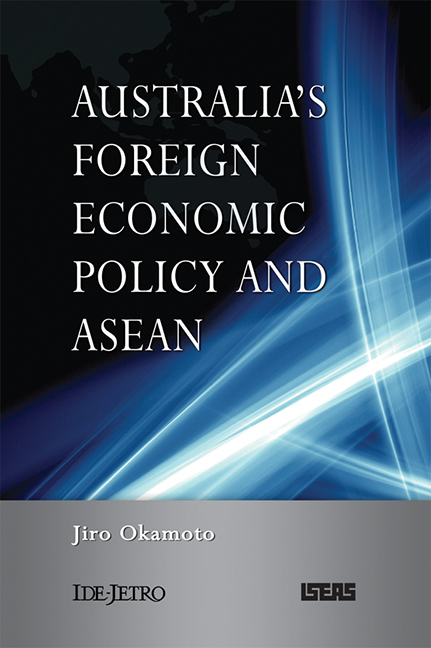Book contents
- Frontmatter
- Contents
- List of Figures and Tables
- Abbreviations and Acronyms
- Acknowledgements
- 1 Introduction
- 2 An Analytical Framework
- 3 State-Society Coalitions and Australia's Foreign Economic Policy
- 4 Australia and the Formation of ASEAN
- 5 The Trade Liberalizers and Asia-Pacific Regionalist Strategies
- 6 The Development of ASEAN Regionalism and the AFTA–CER Linkage Dialogue
- 7 The Bilateralists and their ASEAN Policy
- 8 Conclusion
- Appendix: Foreign Economic Policy-Related Ministers in Australia since 1941
- References
- Index
- About the Author
6 - The Development of ASEAN Regionalism and the AFTA–CER Linkage Dialogue
Published online by Cambridge University Press: 21 October 2015
- Frontmatter
- Contents
- List of Figures and Tables
- Abbreviations and Acronyms
- Acknowledgements
- 1 Introduction
- 2 An Analytical Framework
- 3 State-Society Coalitions and Australia's Foreign Economic Policy
- 4 Australia and the Formation of ASEAN
- 5 The Trade Liberalizers and Asia-Pacific Regionalist Strategies
- 6 The Development of ASEAN Regionalism and the AFTA–CER Linkage Dialogue
- 7 The Bilateralists and their ASEAN Policy
- 8 Conclusion
- Appendix: Foreign Economic Policy-Related Ministers in Australia since 1941
- References
- Index
- About the Author
Summary
The previous chapter examined how Australia–ASEAN relations deepened through multilateral cooperation frameworks such as the Cairns Group and APEC, against the backdrop of the Australian Government' deployment of Asia-Pacific regionalist strategies since the mid- 1980s. This chapter focuses on the bilateral relations between Australia and ASEAN after the reorientation in Australia's foreign economic policy. It explains why in the 1990s ASEAN strengthened and extended its own regional cooperation efforts in dealing with international and regional issues and how the Australian Government responded to this.
The chapter first reviews the development of ASEAN regional political and economic cooperation in the 1990s. It explains that the relatively successful management of the organization and the rapid economic development of its members helped ASEAN build confidence, and this confidence led ASEAN to adopt regional strategies in coping with the political and economic challenges that emerged in the 1990s.
The Australian Government declared “comprehensive engagement” with Southeast Asia in the late 1980s and viewed relations with ASEAN and its members as the basis of Australia's East Asian policy. Among ASEAN' regionalist strategies, its initiative to create AFTA had a potential to shake the basis of Australia's foreign economic policy. Through the maintenance of a continuous dialogue process, the government attempted to make AFTA as open as possible.
While the development of this dialogue was Australia's response to ASEAN regionalism in the 1990s, the dialogue process did not, however, yield the concrete results that Australia hoped for. The unsatisfactory progress of the dialogue with ASEAN was to become one of the main factors behind a second major shift in Australia's foreign economic policy at the turn of the century.
THE DEVELOPMENT OF ASEAN REGIONAL COOPERATION
The main objectives of the establishment of ASEAN in 1967 were to preserve independence and autonomy as far as possible and to stabilize the region for individual member states’ political and economic development. Since then, ASEAN has been gradually institutionalizing its organization and developing political and economic cooperation schemes. In particular, the inaugural Summit meeting held in Bali in 1976 marked a watershed in the development of ASEAN regional cooperation.
- Type
- Chapter
- Information
- Australia's Foreign Economic Policy and ASEAN , pp. 163 - 203Publisher: ISEAS–Yusof Ishak InstitutePrint publication year: 2010



